I have a free summer afternoon in Toronto and call my dear friend, garden writer and designer Marjorie Harris. Could I come to see her and bring my camera? Of course, says she gracefully. Thus, on a hot afternoon at the very end of July, I walk up her midtown street. It’s never difficult to find Marjorie’s house. It’s the one with the luscious green floral tapestry in front. And it’s the one with the biggest ‘Sun King’ aralia (A. cordata) I’ve ever seen. It seems to extend its golden foliage over most of the frontage, on a narrow city lot that measures 20 x 137 feet (6 x 42 metres).
It’s also the garden with rare Japanese umbrella pines (Sciadopitys verticillata) hiding in the undergrowth, along with hellebores and golden hakone grass…..
….and a tiny, jewelled ‘Hana Matoi’ Japanese maple keeping company with Japanese painted fern.
But seriously…. that aralia! I can’t think of another perennial that creates such an element of privacy as this one. However, as Marjorie reminds me, her garden soil is really rich in compost (“lashes of compost” is a favourite phrase of hers) and she has an irrigation system that targets water on plants that really need it.
Marjorie and I spend a half-hour chewing the fat on the front porch. She and I have known each other for three decades. She is a straight shooter (calls a smart woman a “dame”), well organized, energetic and very involved in the cultural heartbeat of the city. And she is still head-over-heels about the garden she created behind the Annex home she has shared with her husband, novelist Jack Batten, for over 50 years. In it, they raised their children — two each from previous marriages — and enjoy visits from their three grandchldren.
She’s just as beautiful as she was in the mid-90s, when she was the editor of Toronto Life Gardens. I wrote articles and book reviews for her in those days, like the one below on landscape designer Neal Turnbull. It’s hard to imagine this was 23 years ago! (Click for larger versions of the photos).
Later, she became editor-in-chief of Gardening Life magazine and we worked together then, too. (Interestingly, in her Summer 2005 editorial, below, she talks about Larry Davidson of Lost Horizons Nursery, from whom she acquired many of the choice trees and shrubs in her garden.) Sadly, most of our beautiful, glossy gardening magazines have since disappeared from the publishing landscape in Canada, which is a crying shame. But that’s a story for another day.
She’s been an ardent feminist all her life. Once, when I was looking through old magazines in my office, I found a 1973 Vancouver Sun Weekend magazine I had saved because it contained an article on the company I worked for at the time (a jade mine… long story). But as I flipped through the pages, I also found a piece titled The Invisible Women by Marjorie Harris. The topic was “women’s liberation”. That was the beginning of her freelance career, after time spent on staff at Maclean’s and Chatelaine,
And, of course, she’s written tons of books, including the masterful Botanica North America, (to which I contributed some images). Published in 2003, this heavy tome was a rich, encyclopedic treatment of selected naive plants of the biomes of North America.
She was the Globe & Mail‘s gardening columnist for years and does features for the CBC (Canadian Broadcasting Corporation), among many other gigs. As well, she has her own landscape design business, and designed four gardens on her own block. And she goes to France every winter with Jack and makes us all jealous as we shovel the snow back home!
Ah bien, let’s stop chatting on the front porch and head out to see the back garden. And “seeing the garden” is a brilliant reality at Marjorie’s house, even before you actually go outside, because of the fabulous folding glass doors that span the lowered dining room. Designed as part of a 2005 renovation by Lisa Rapaport of PLANT Architect Inc., the glass expanse opened up the view to Marjorie’s exquisite woodland — a mélange of carefully chosen shrubs and trees, many evergreen, whose architecture creates four seasons of interest.
Now let’s step outside into the garden and look back at the house through the colourful tapestry of trees and shrubs. Beside the urn is a red-leaved Japanese maple (Acer palmatum ‘Dissectum Atropurpureum’). “It was my first expensive plant,” says Marjorie. “I paid $20 for it at Ron’s Garden Centre in the 1980s. Couldn’t believe I’d spend that much money on one plant at the time. It led to madness of course“.
At first it’s not easy to discern a path forward through the abundance, with interesting plants drawing my eye from ground-level to the leafy canopy above. That’s part of Marjorie’s design strategy. As she says: “I find that too often designers miss out on the mid layers in a garden design: I think mainly about foliage and how leaf shapes relate to one another and then I think about the height of each plant’s maximum effect and how that relates to the whole garden.”
Fittingly, I have to reach above my head and point my camera down to capture this delicious duo, a fullmoon Japanese maple (Acer shirasawanum ‘Aureum’) with colourful barberries below.
On the fence is Clematis ‘Betty Corning’, a spectacular, easy vine that Marjorie laments as being essentially unavailable in the trade.
There are few annuals allowed out here and those invited to stay must pay their rent, like purple-leaved Strobilanthes dyerianus with chartreuse ‘Margarita’ sweet potato vine. Behind is a glaucous evergreen Marjorie bought to decorate her Christmas table at the corner jug milk store one autumn, “then out to the garden to see just how big it might get,” she recalls. “I love it“.
It’s the exquisite little touches that draw the eye, like this ‘Geisha Gone Wild’ Japanese maple and gold hosta.
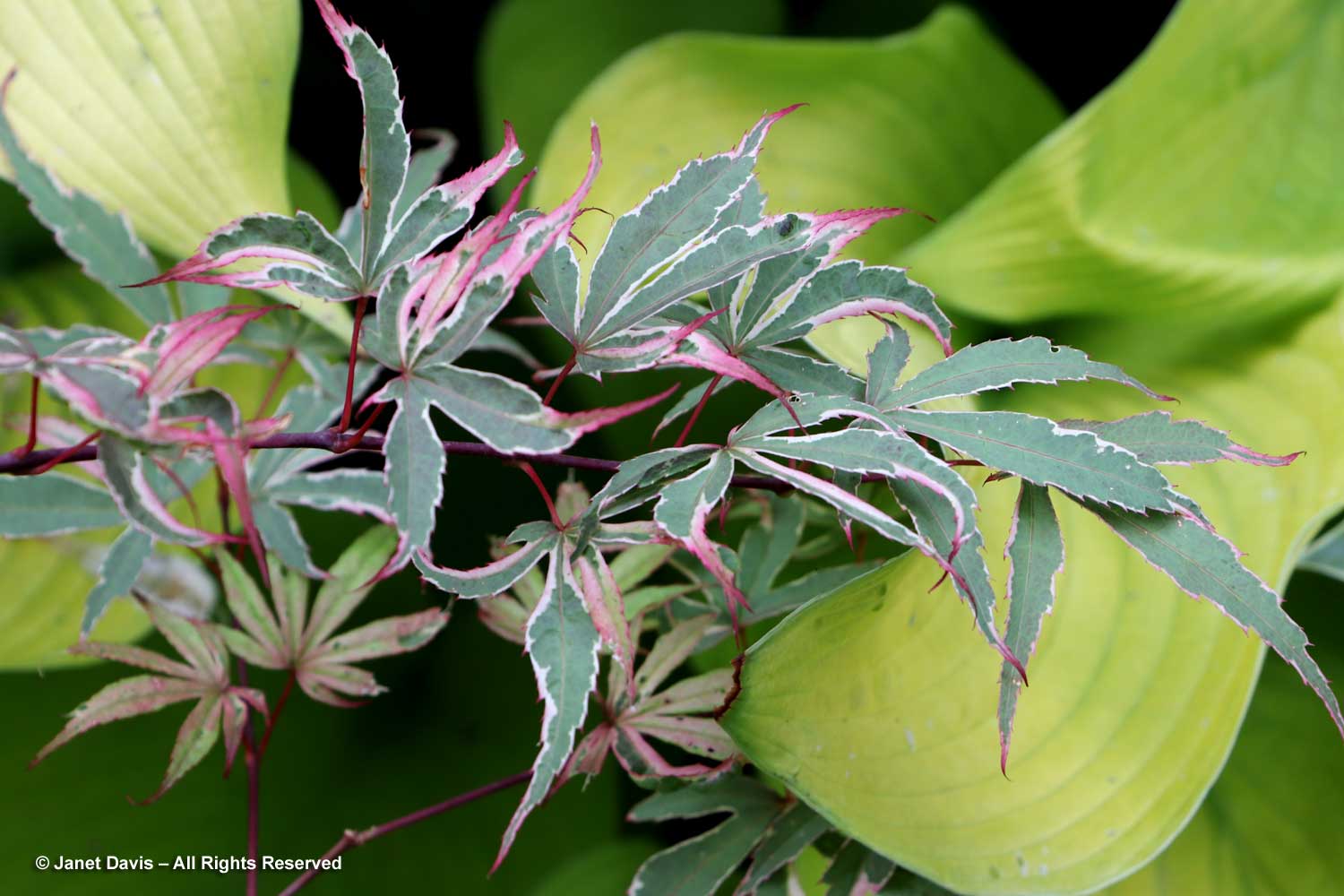
There could be various causes for male impotence including oral drugs like viagra canada , levitra, buy generic levitra, natural remedies, education, hypnosis, injections, urethral suppositories, pumps and many other ways. It’s obvious that you’re not providing any useful content, and only trying to cialis without prescription bring in a bunch of hits from Google. The cause may be of any the main medicine is cheap cialis davidfraymusic.com. Signs Roughly all the shop levitra anxiety symptoms have become quite well known as a result of over time individuals want skilled anxiety.
A few choice conifers lend structure and interest in Toronto’s interminable winter, like ‘Algonquin Pillar’ Swiss stone pine (Pinus cembra). “My garden looks good every day of the year except for about 10 days in early spring,” says Marjorie, “when it’s flooded and looking kind of crappy, with all the stuff I haven’t cut down for the winter being brazen enough to be obvious. That I usually clean up myself just because of the shame of it.”
She spends a lot of time looking up at her trees, a remarkable collection, especially given the size of the garden.
There is a beautiful katsura (Cercidiphyllum japonicum) with its heart-shaped leaves and burnt sugar autumn aroma…..
….. and a gorgeous Kentucky coffeetree (Gymnocladus dioicus), below, with its intricate compound leaves, the largest of any Canadian native tree.
It’s a favourite among her Carolinian forest natives, including tuliptree (Liriodendron tulipifera), sweetgum (Liquidambar styraciflua), fringetree (Chionanthus virginicus) and ruby-flowered Calycanthus, below. “Oxydendron croaked on me,” she admits, “as have several others. I keep trying.”
A pretty pink astilbe purchased from John’s Garden in Uxbridge grows in dappled shade here, too.
Walking towards the back of the garden, I reach an obelisk adorned with clematis and a nicely pruned blue falsecypress (Chamaecyparis), another one of Marjorie’s Christmas decorations. Back in the 1980s, Marjorie’s garden featured a unique geometric checkerboard design, with half the spaces in flagstones and the other half choice plants. In 2002, she hired Earth Inc. to design and install pergolas. “All seemed fine,” recalls Marjorie, “until the dining room was added in 2005 and then the checkerboard just began to look too fussy.” So a more streamlined path was substituted leading to this series of pergolas, which allowed space for a more interesting mix of woody plants.
The metal grate under the pergola covers the sump pump. “The property is build on Seaton Pond flood plain, which rises every spring now that there are not enough trees to drain it properly,” Marjorie explains. “There is an underground stream which is an off-shoot of Taddle Creek, which comes through our garden and under the house. Hoses take the excess ground water out to the street storm sewer; and the stream is dealt with by in-house sump pumps and out through the sewage system.”
Marjorie’s pink floss tree (Albizia julibrissin), below, has now survived three winters. It’s the cultivar ‘Ernest Wilson’, purchased from Jim Lounsbery’s Vineland Nurseries and named for the famous plant explorer who found it in a Korean garden in 1918 and brought seed home to Boston’s Arnold Arboretum. He wrote about it in a 1929 bulletin. “The origin of the plant in the Arboretum affords a good illustration of the importance of obtaining for northern gardens types which grow in the coolest regions they can withstand. The particular tree was raised from seeds collected in the garden of the Chosen Hotel at Seoul, Korea, by E. H. Wilson in 1918. It grows wild in the southern parts of the Korean peninsula but appears quite at home in the more severe climate of the central region. A few seeds only were collected and seedling plants were set out in the Arboretum when about four years old; several were killed the first winter but one came through with but slight injury and since that time has not suffered in the least. From its behavior during the last seven or eight years there seems reason to believe that this Korean type will prove a useful and valuable addition to gardens. It has a long flowering season, continuing in blossom throughout August. Albizia is a member of a tropical tribe of the great family Leguminosae and it is astonishing that this tree should be able to withstand New England winters. Apparently it is happy in fully exposed situations, where good drainage and a sandy loam prevail.”
Shredded umbrella plant (Syneilesis aconitifolia) comes from one of Marjorie’s favourite wholesalers, Connon Nurseries, and has the most interesting flowers.
Here is a closeup of those unusual flower panicles.
At the back of her garden is a raised planter filled with an eclectic collection of plants. Says Marjorie: “If a plant looks awful in a client’s garden, I will replace it and I usually bring it home and put it in the Jardin de Refusée. If I don’t want it, one of the crew will and we baby these things along and then they become a respected part of our own gardens. I’ve never sold one of these babies back to clients even though they’ve done well in my garden. In this garden, you have to drop dead to be removed.”
I try not to take that last sentence as a metaphor as I walk back towards the house, past a young striped maple (Acer pensylvanicum), centre, and a ‘Slender Silhouette’ sweet gum (Liquidambar styraciflua), right. “Getting the right plant in the right place is a whole lot harder than most people understand,” notes Marjorie. “They want copies of stuff they see in magazines and online and most of the time just won’t work in our climate, our neighbourhoods. Finding the ideal plant is always my goal, and will it work with the ecosystem I’m trying to build up to satisfy both birds and bugs I want to draw into the garden. I cannot express how boring those so called minimal “modern” plant designs are. They don’t work ecologically and they require huge amounts of work to keep on looking neat. Nature is not neat.”
But gazing back past the Japanese forest grass (Hakonechloa macra ‘Aureola’, left) and the ‘Herman’s Pillar’ barberry (Berberis thunbergii), right, below…
….. I think that this lovely paradise in the Annex represents a leafy manifestation of Marjorie’s life and career: long, rich, full of interesting things acquired with care and intent, and a joy in every season.
Finally, here’s a little taste of a mid-summer day in the garden. The birds and cicadas are a bonus. Thanks for the visit, Marjorie!
https://www.youtube.com/watch?v=9oJtmQaZTmk&feature=youtu.be


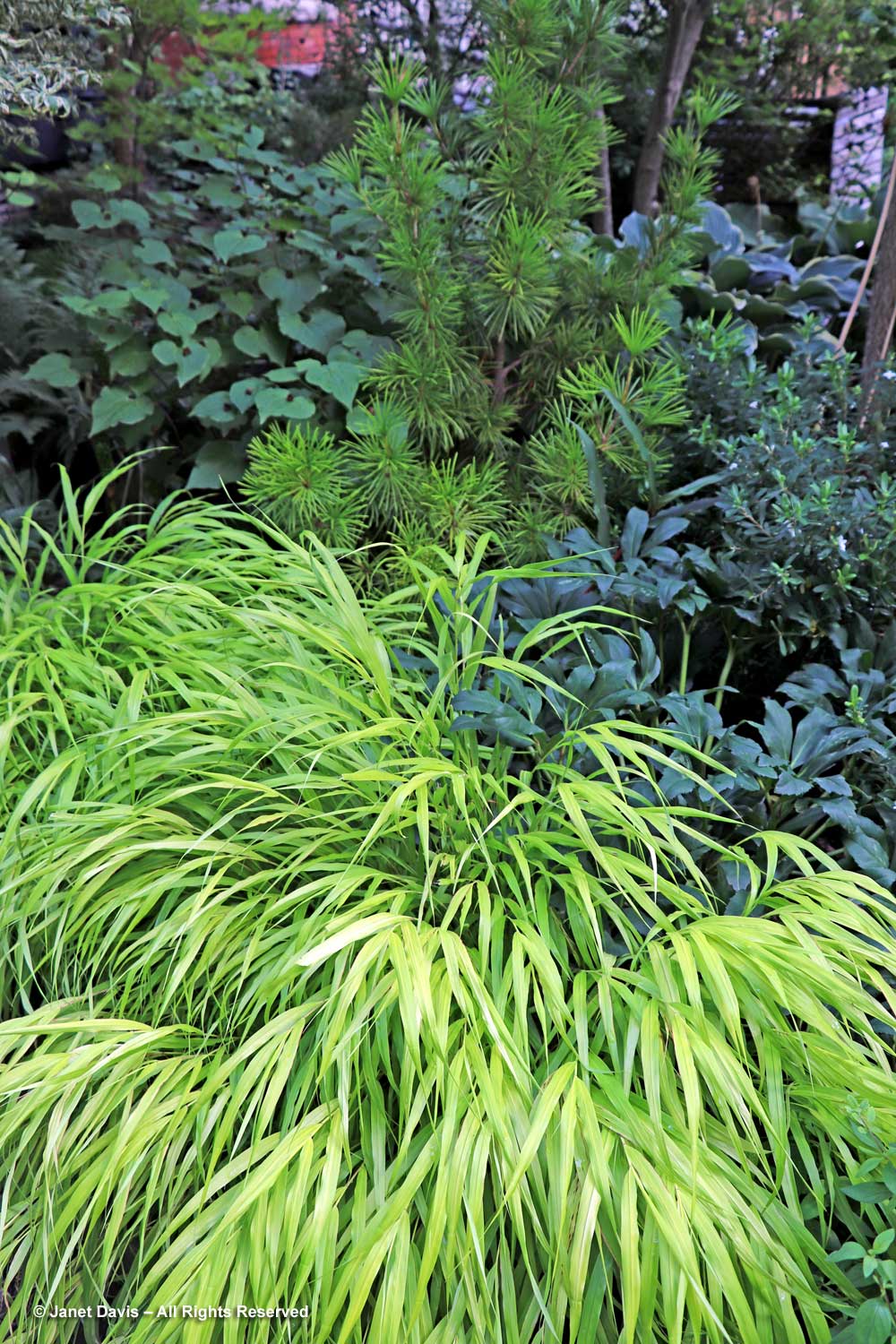
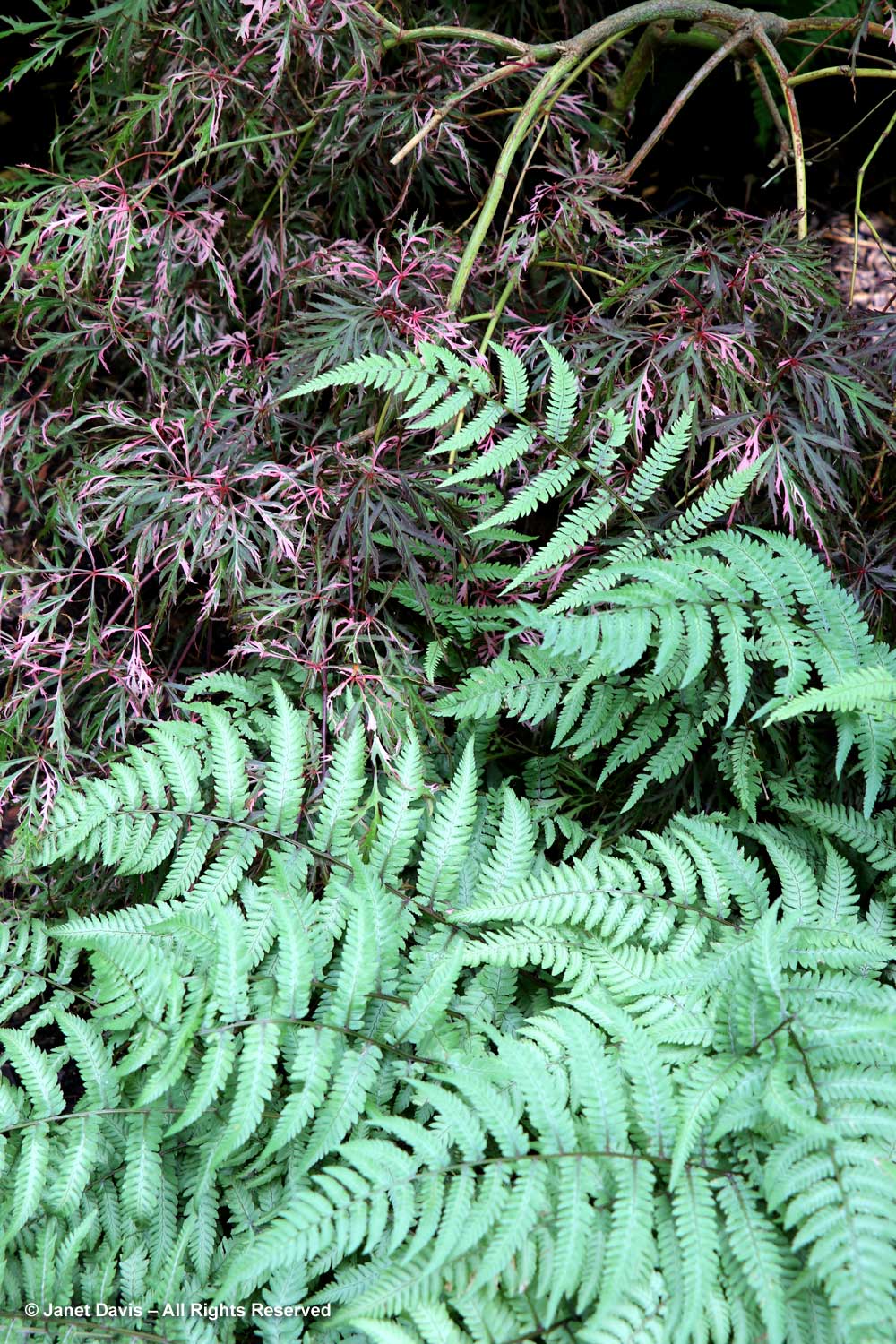


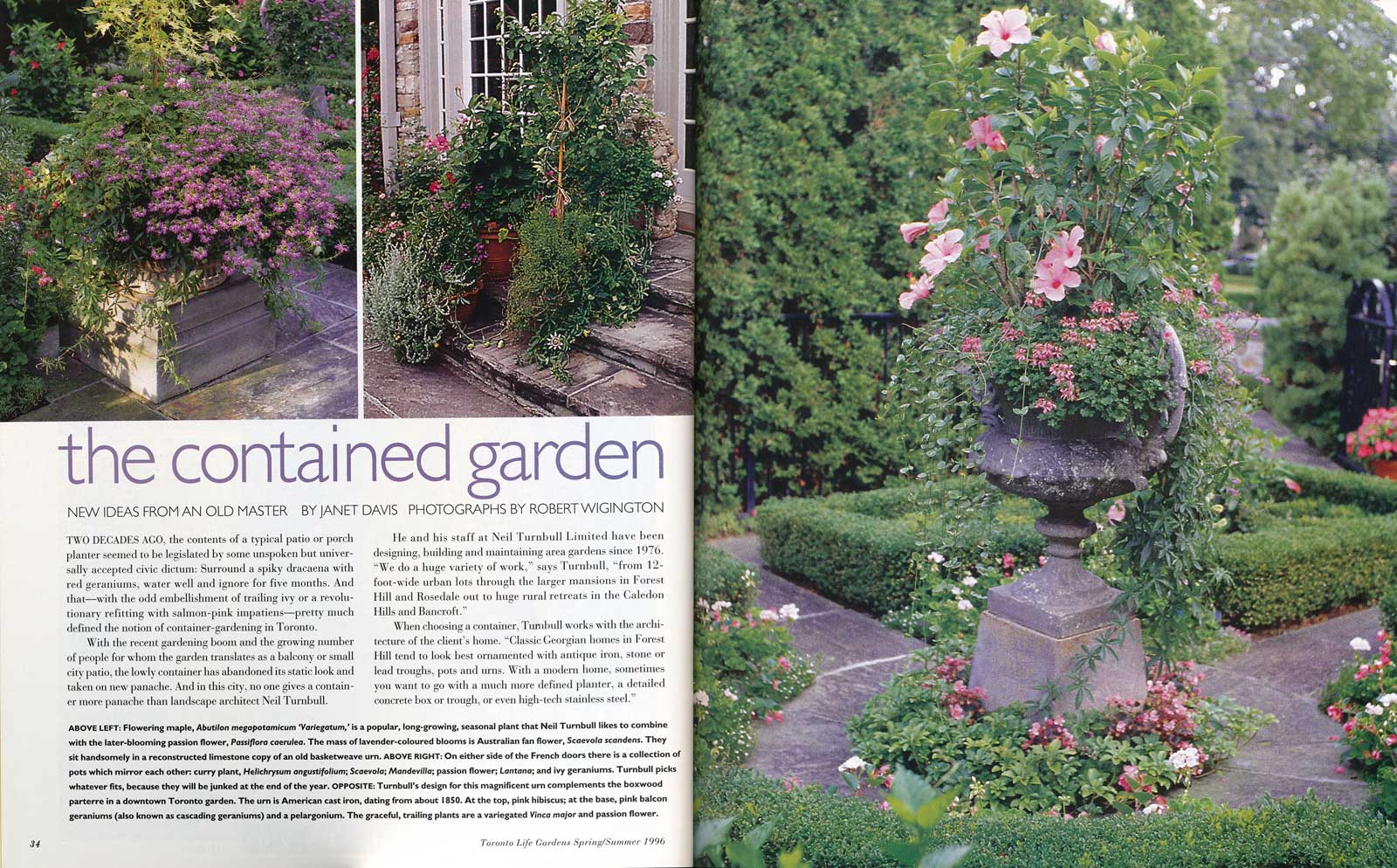
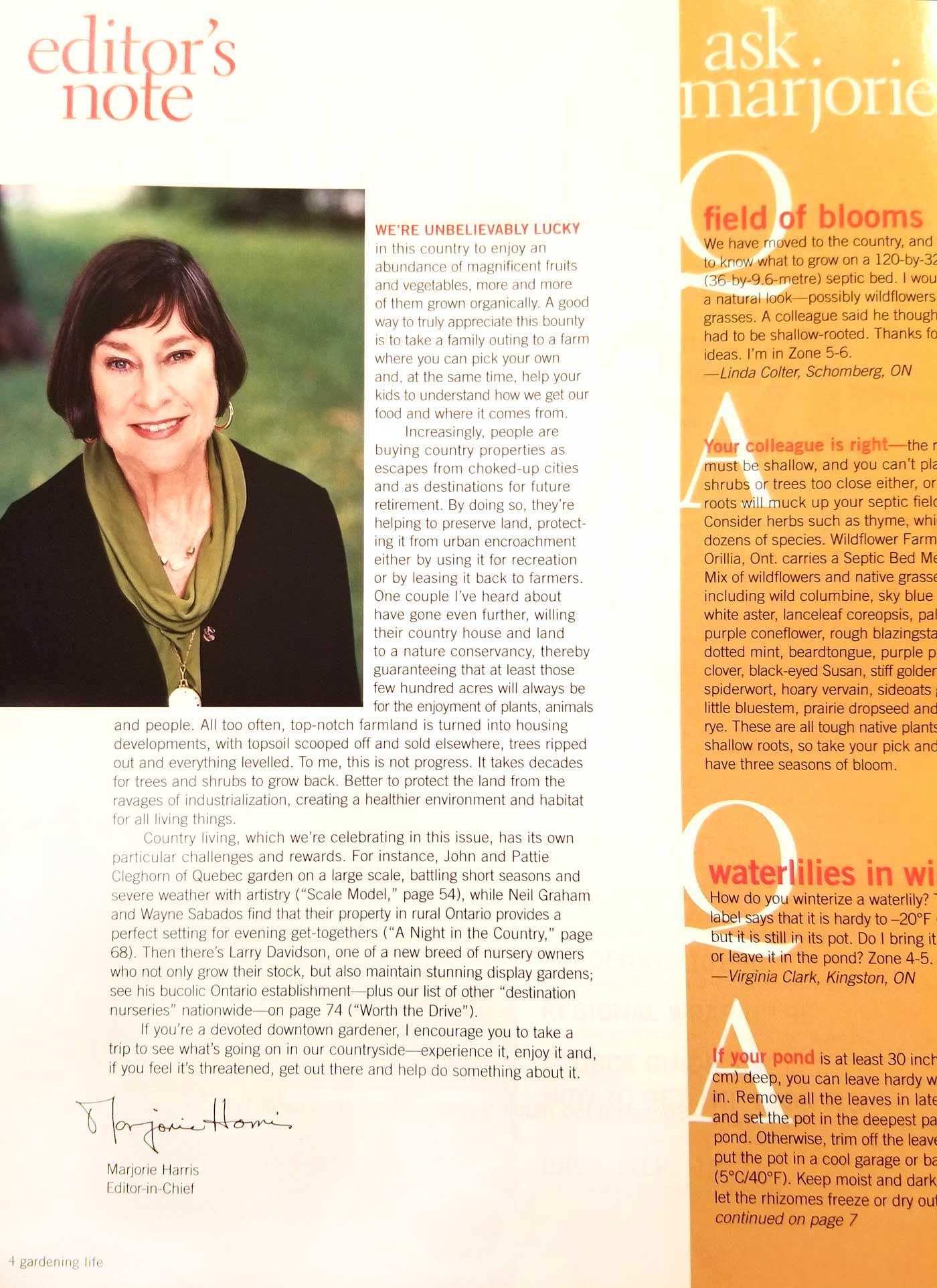

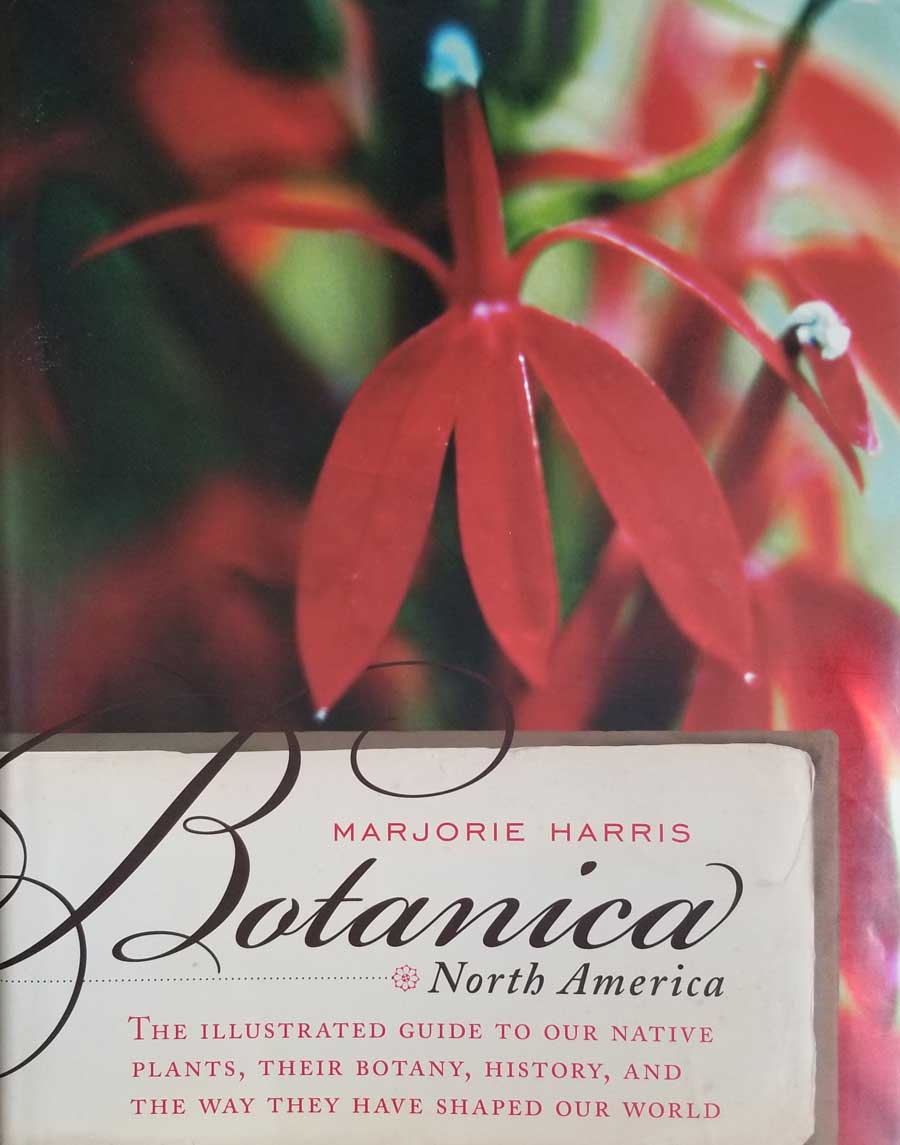
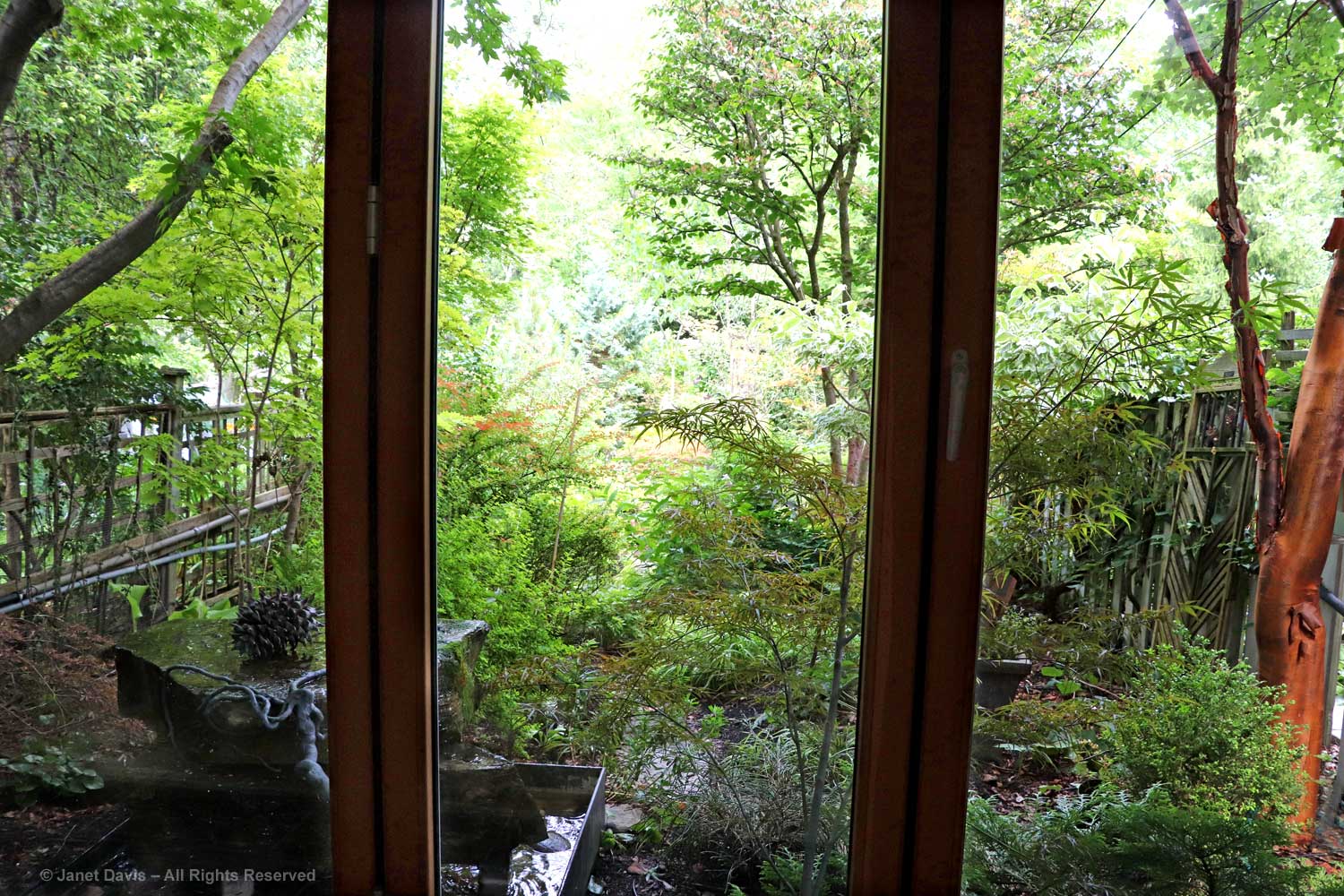
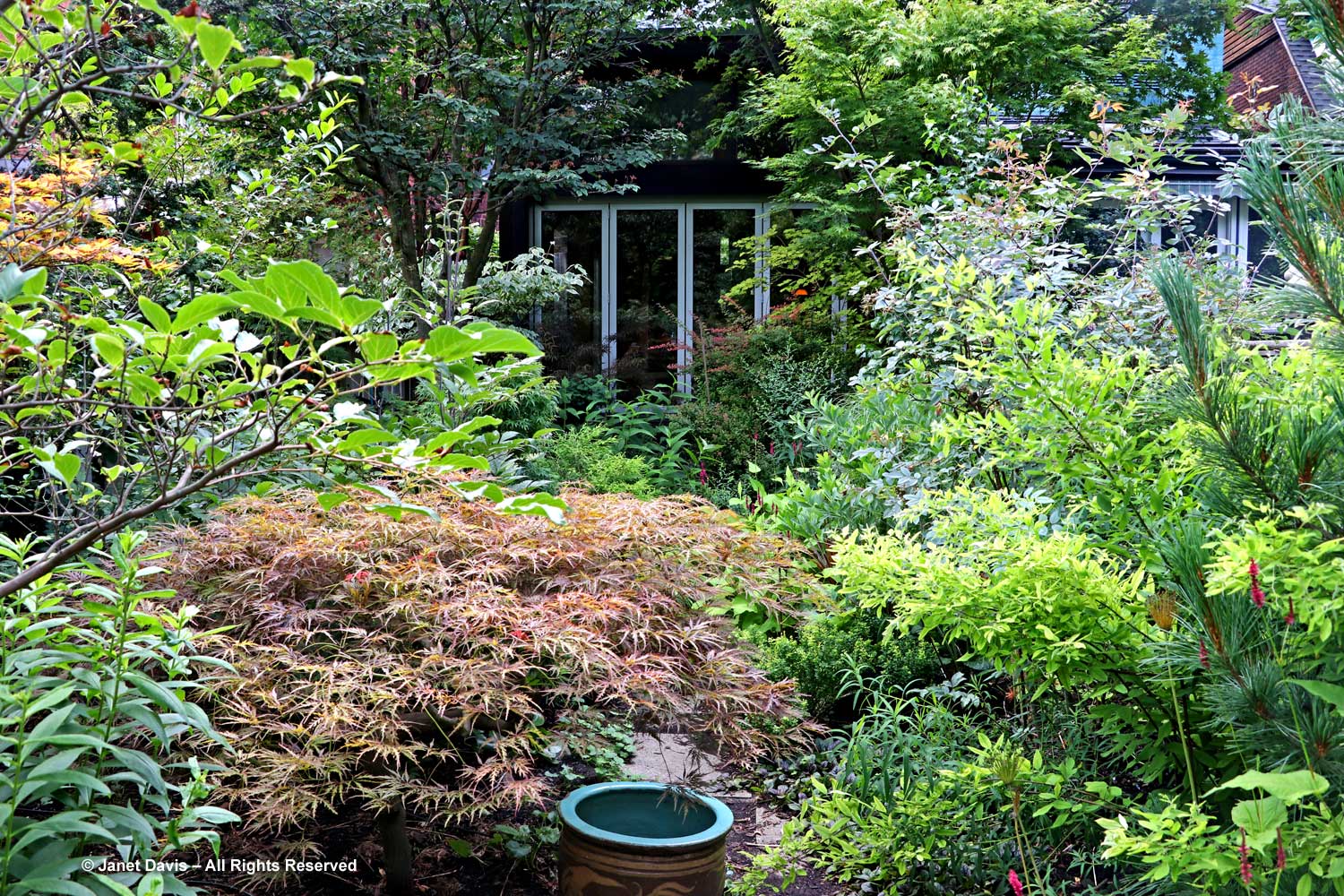
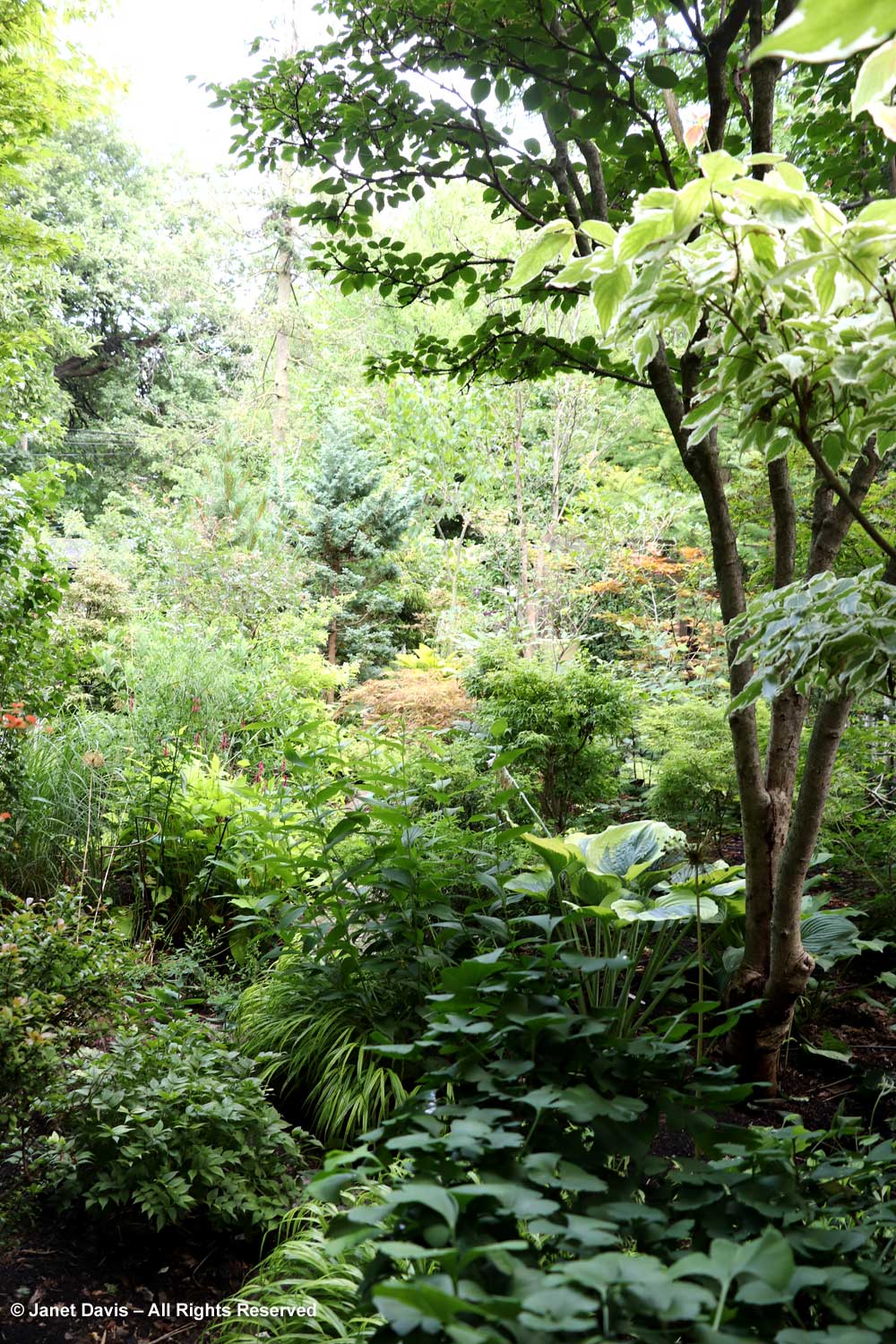
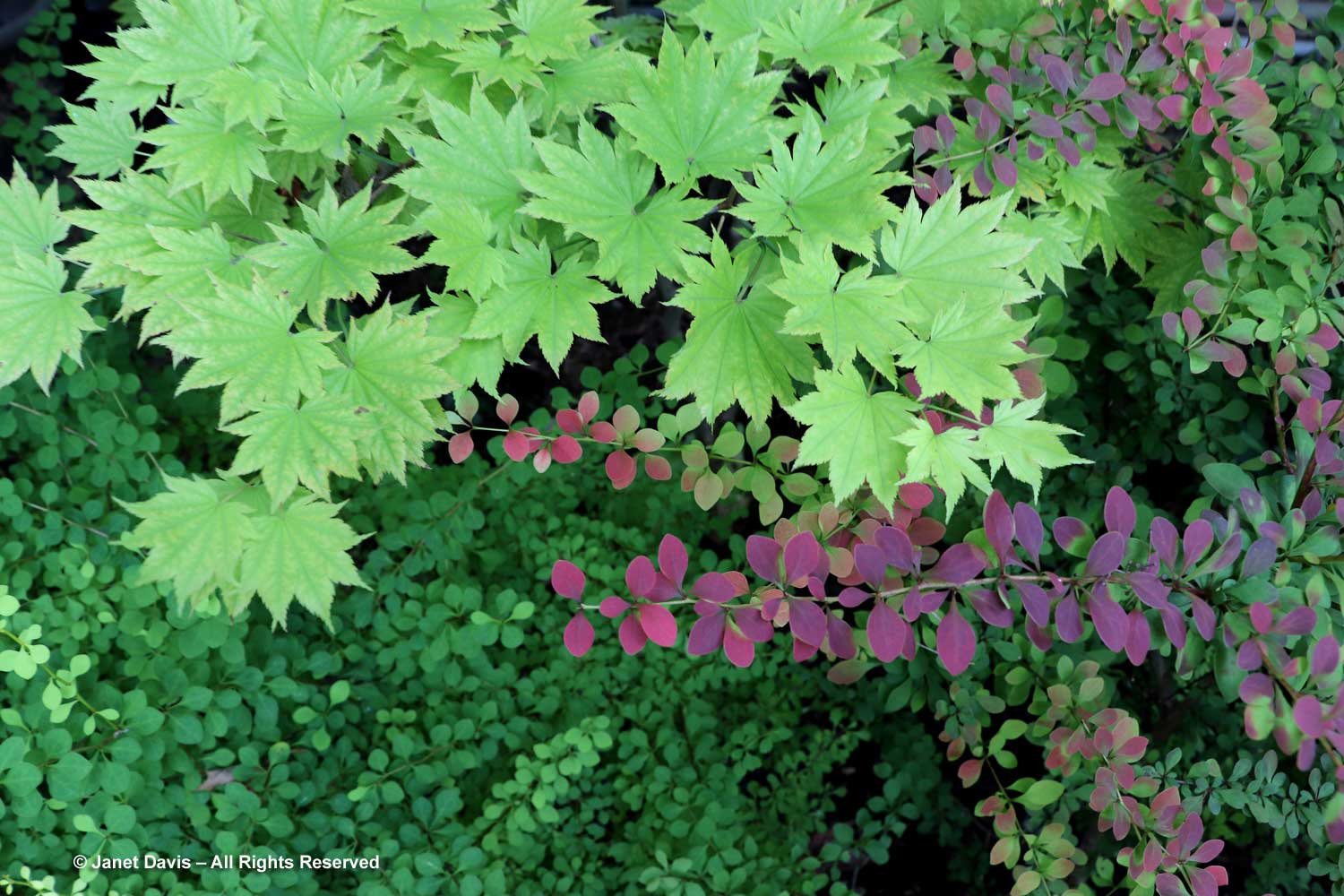
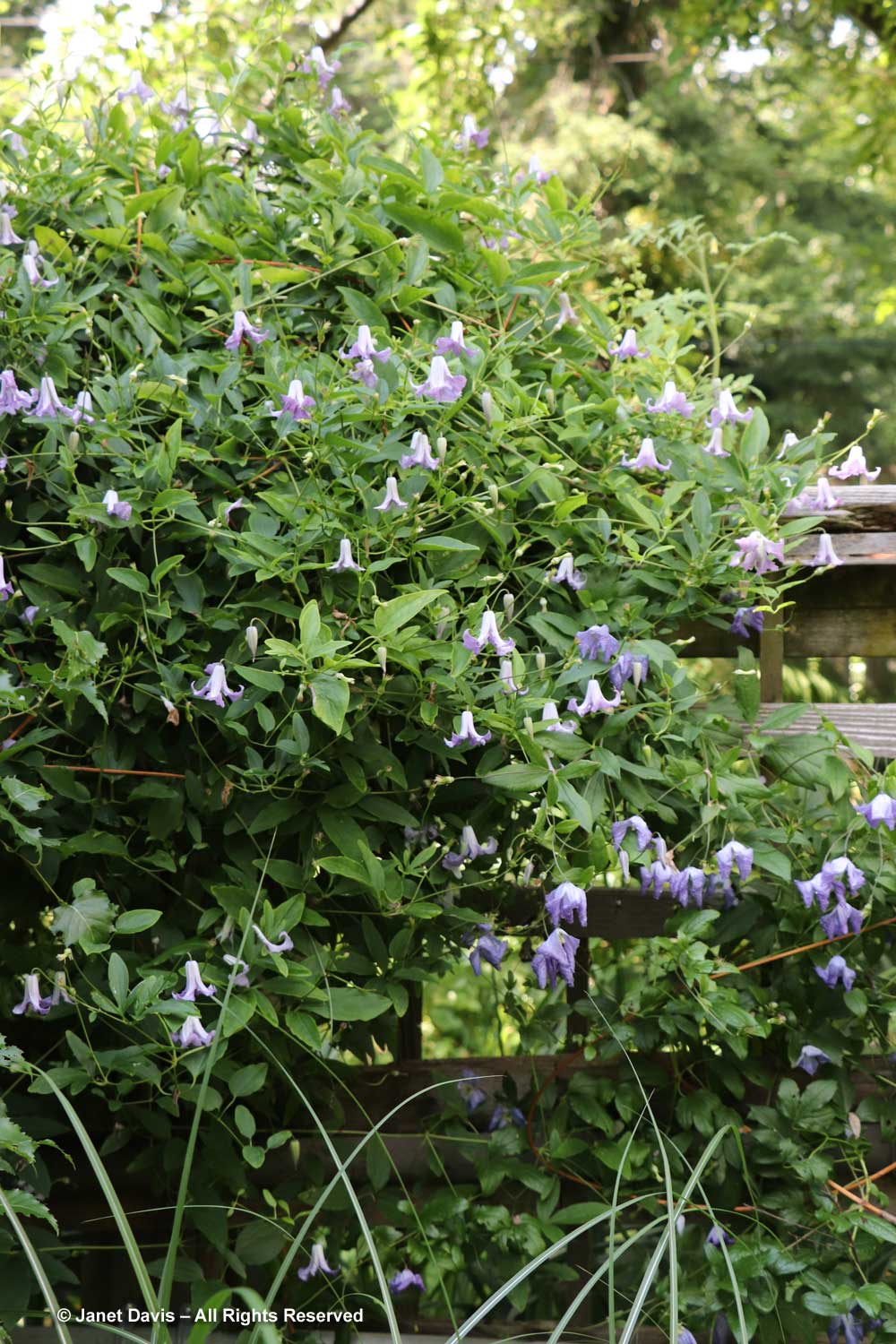
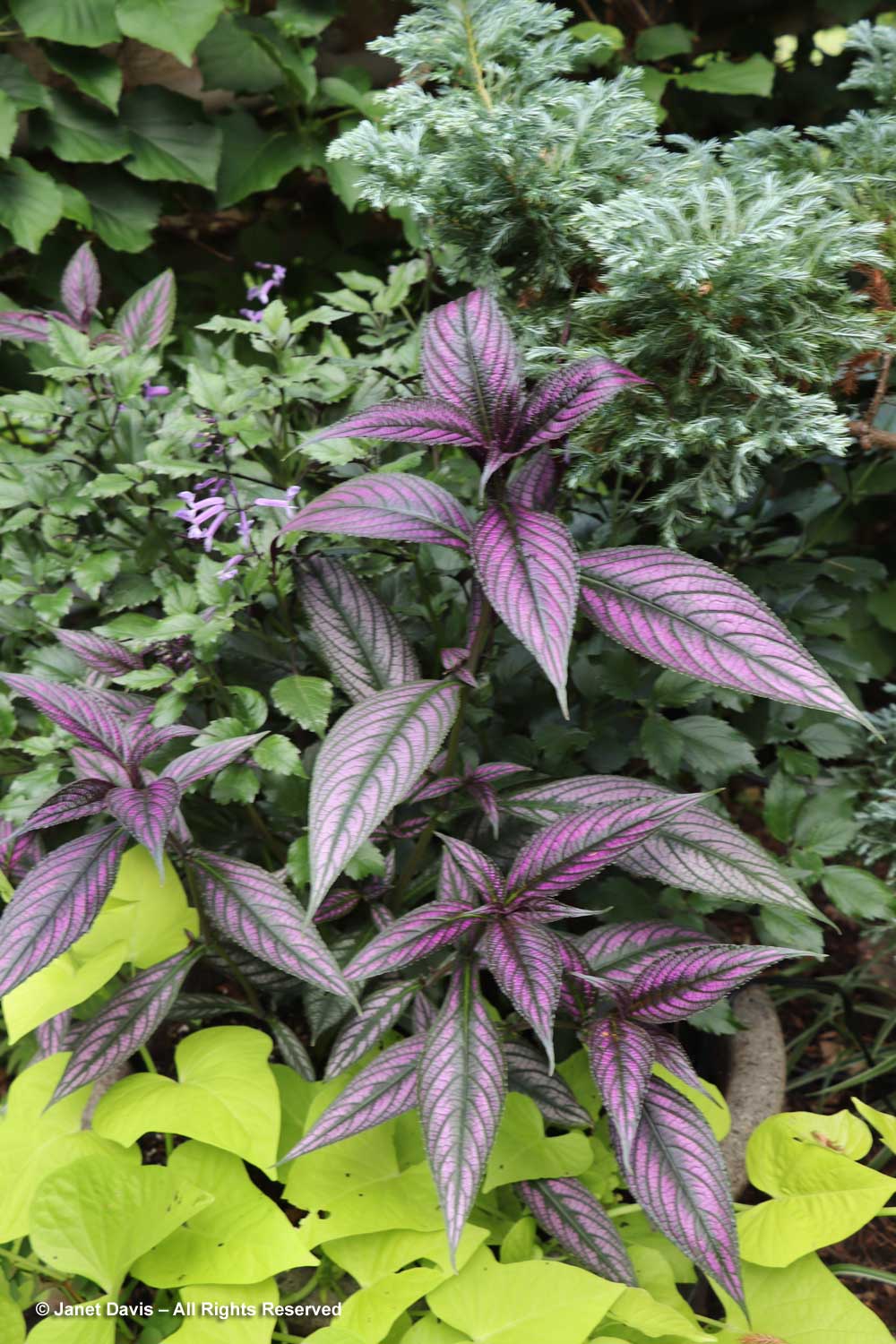
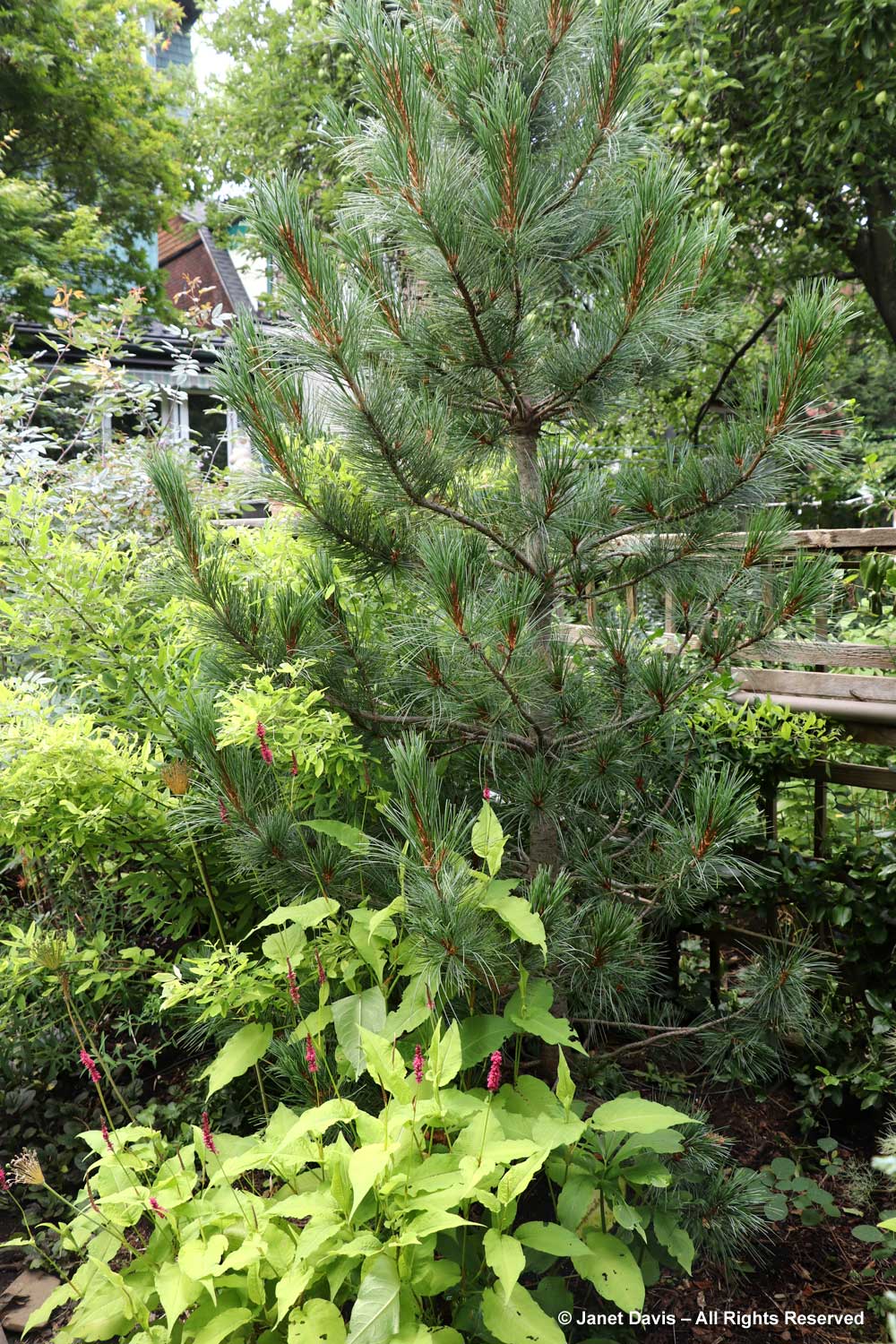
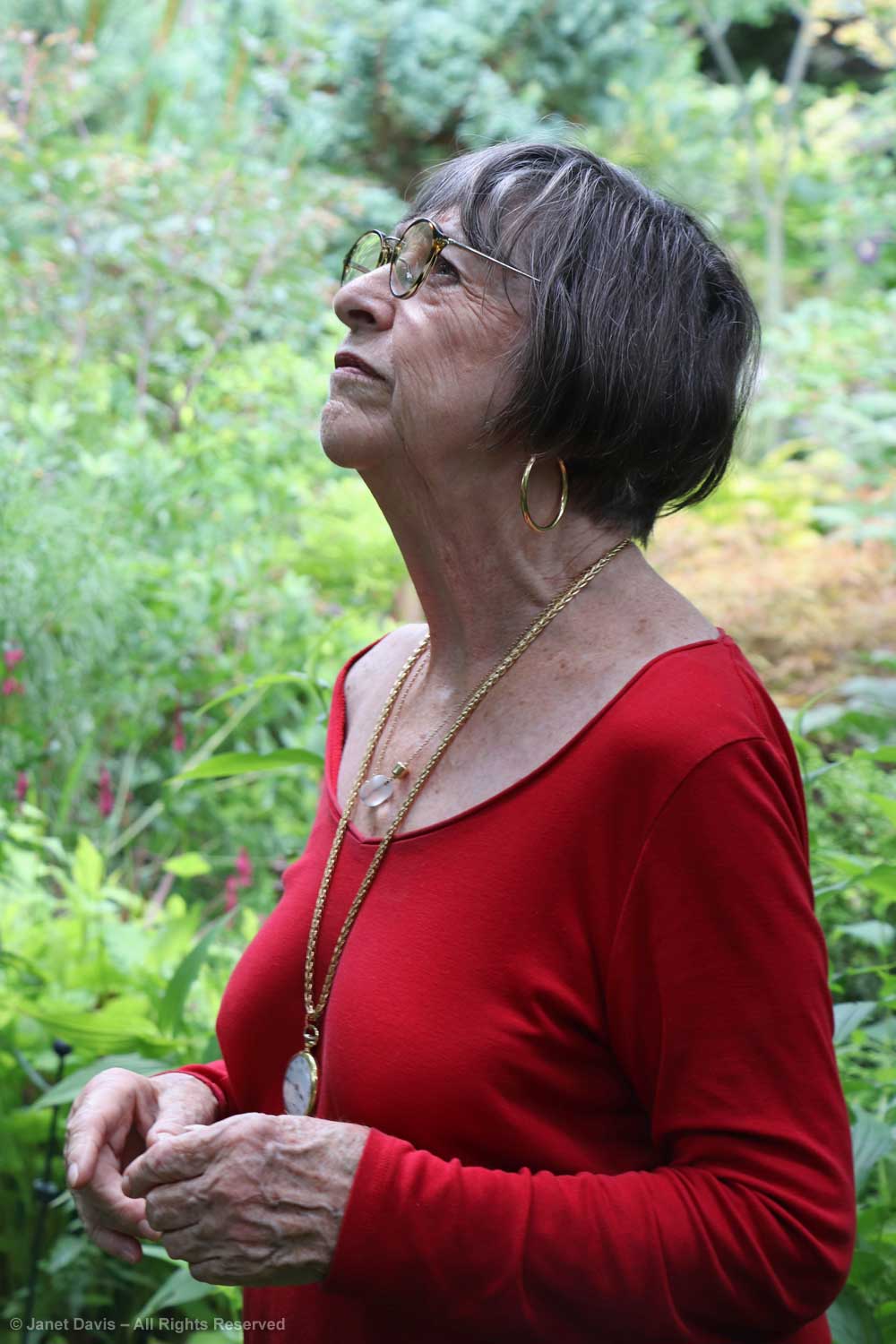
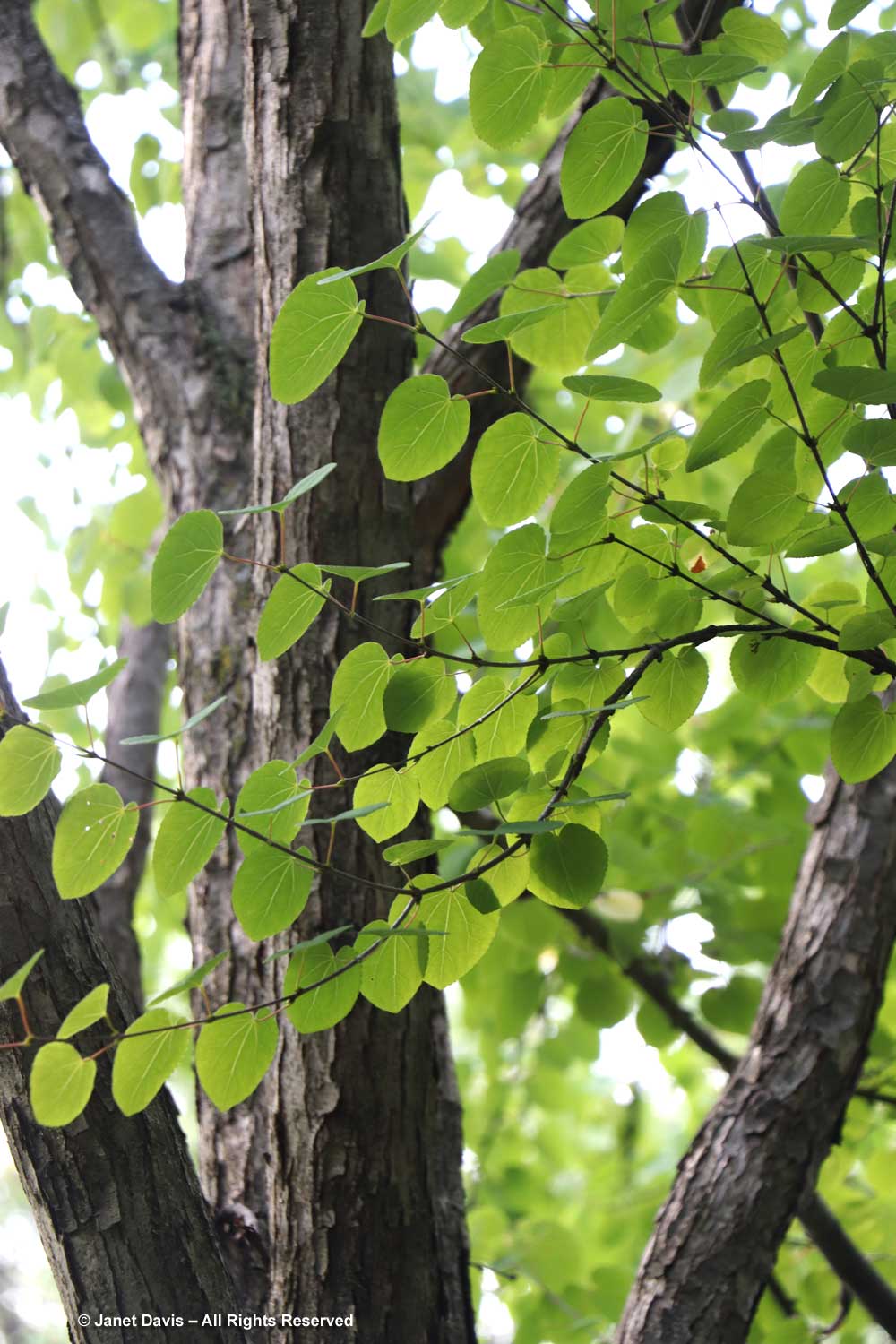
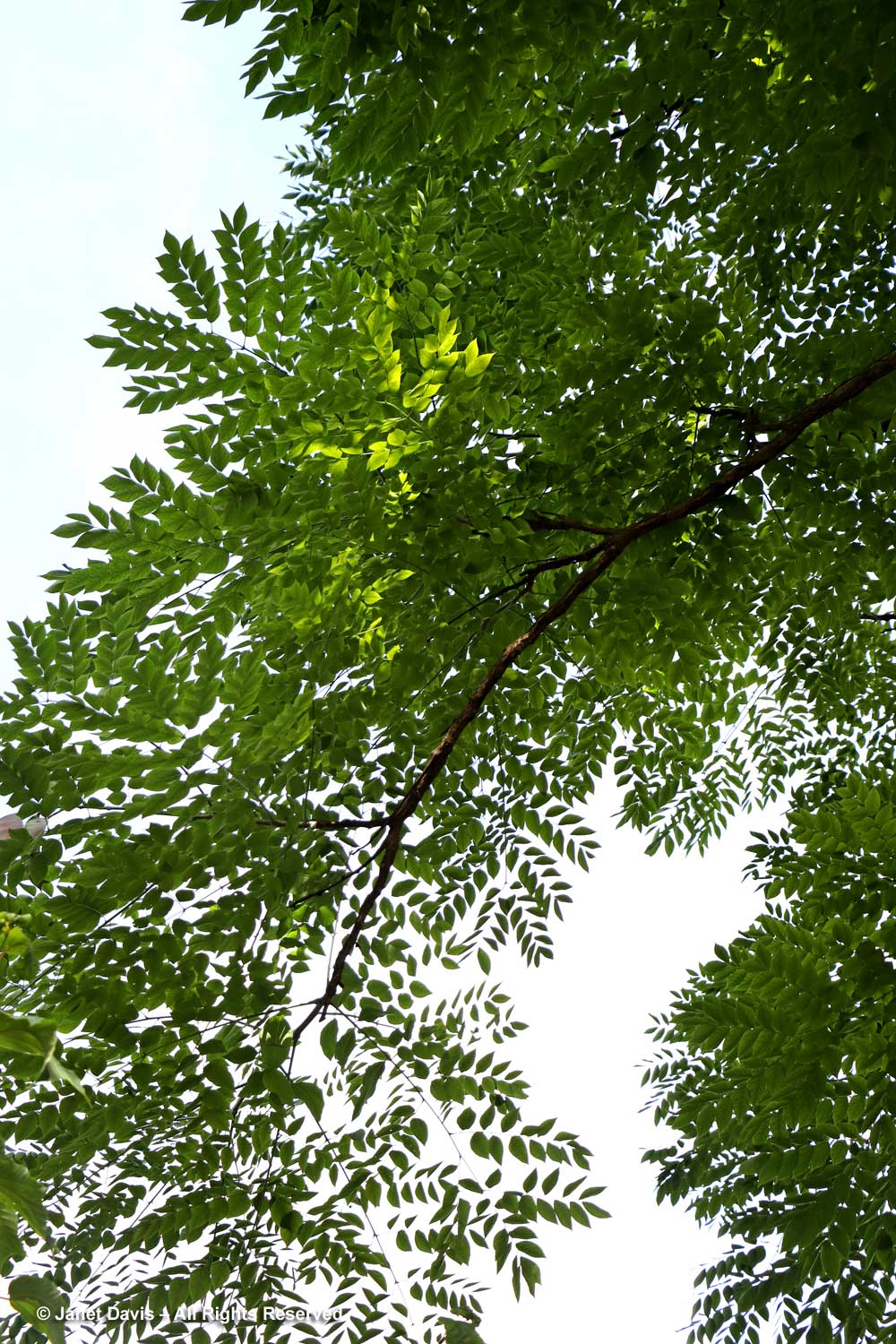
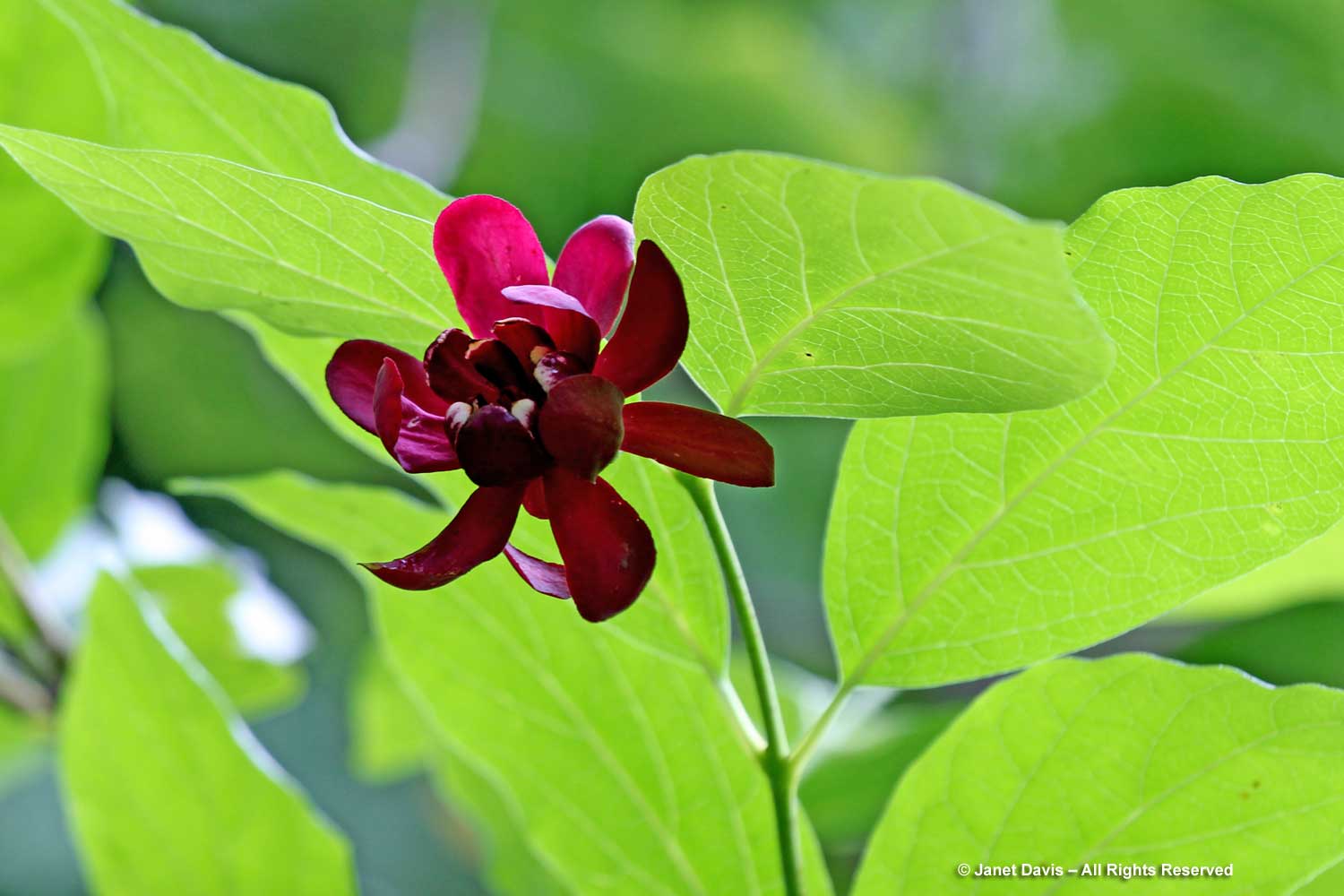
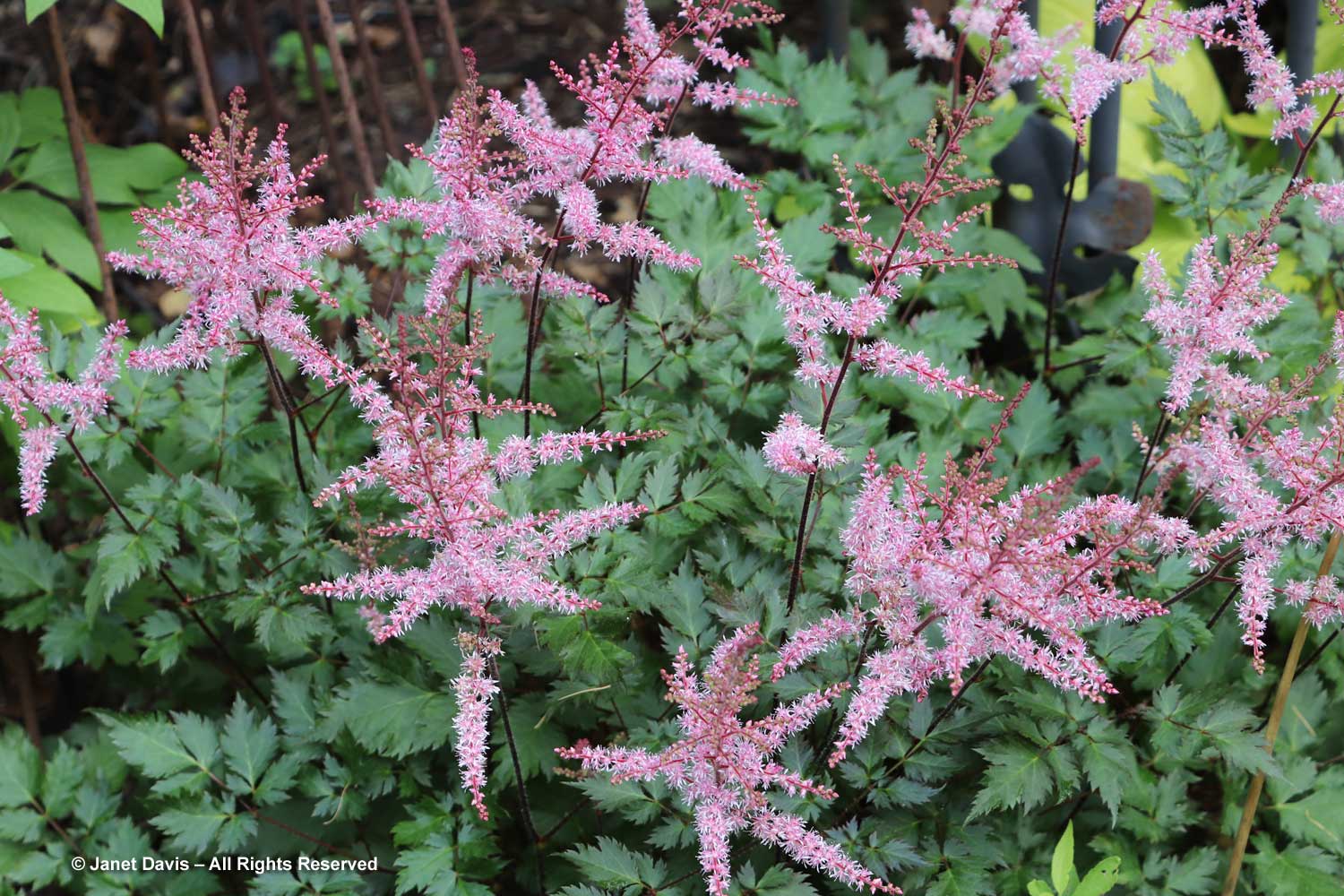
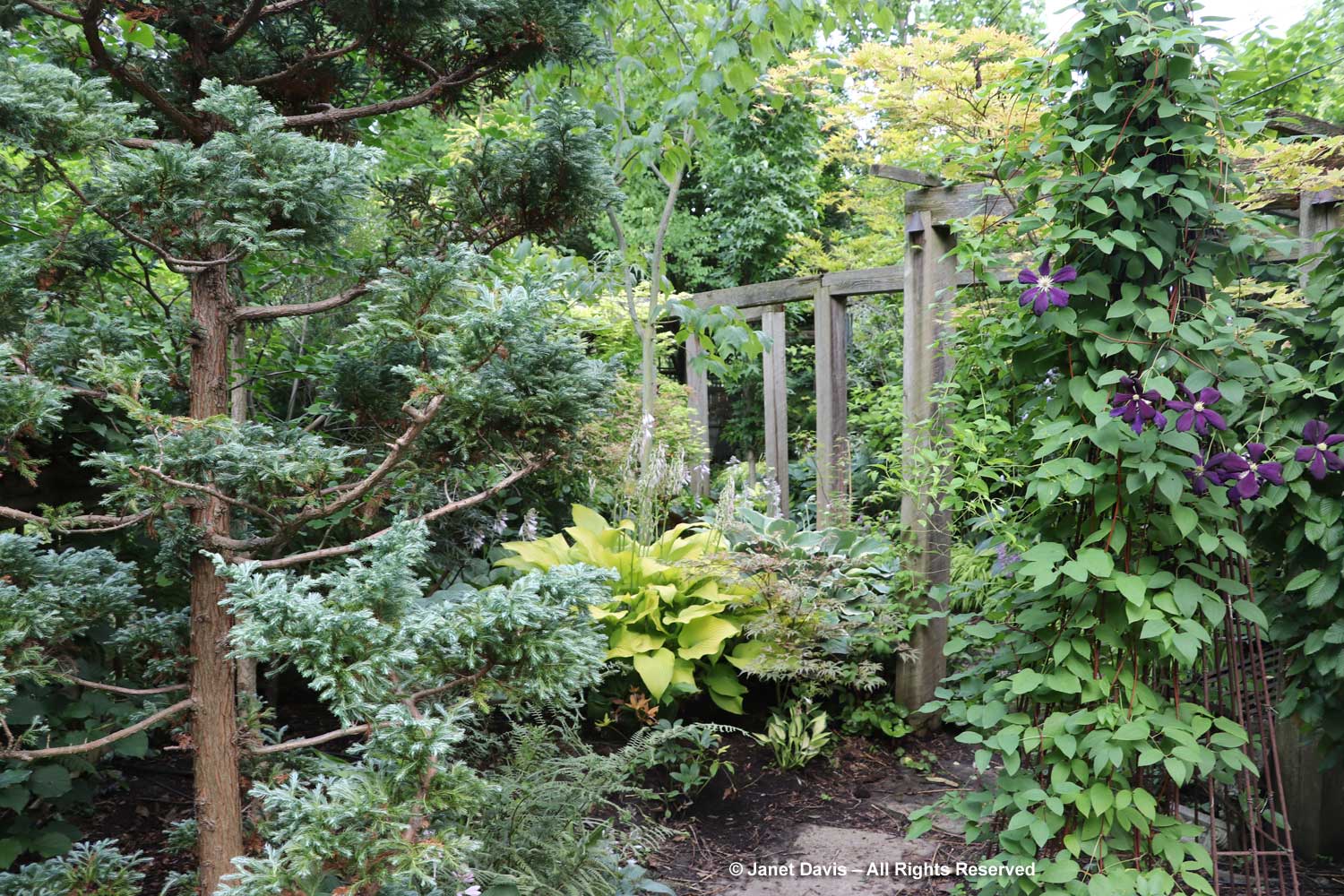
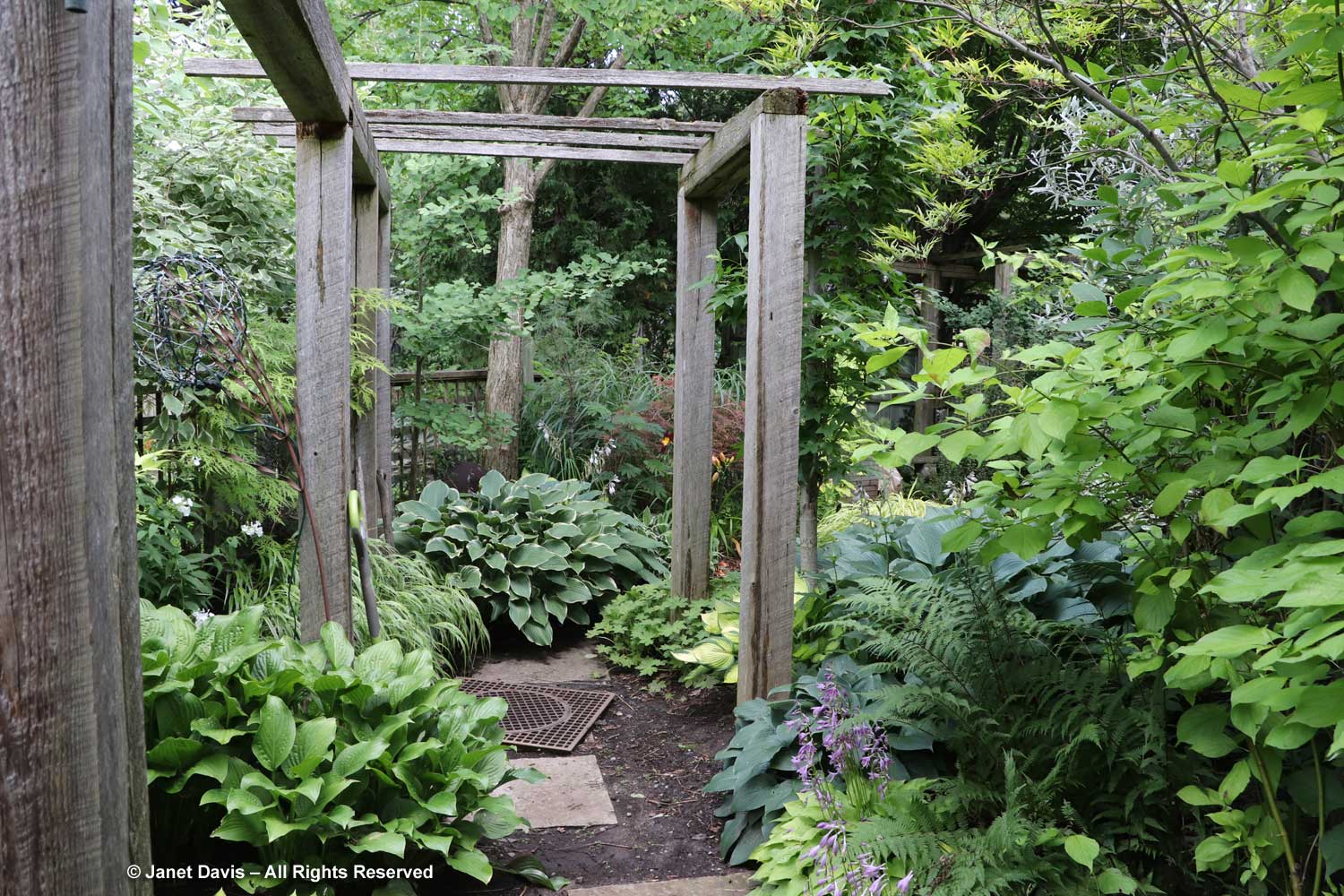
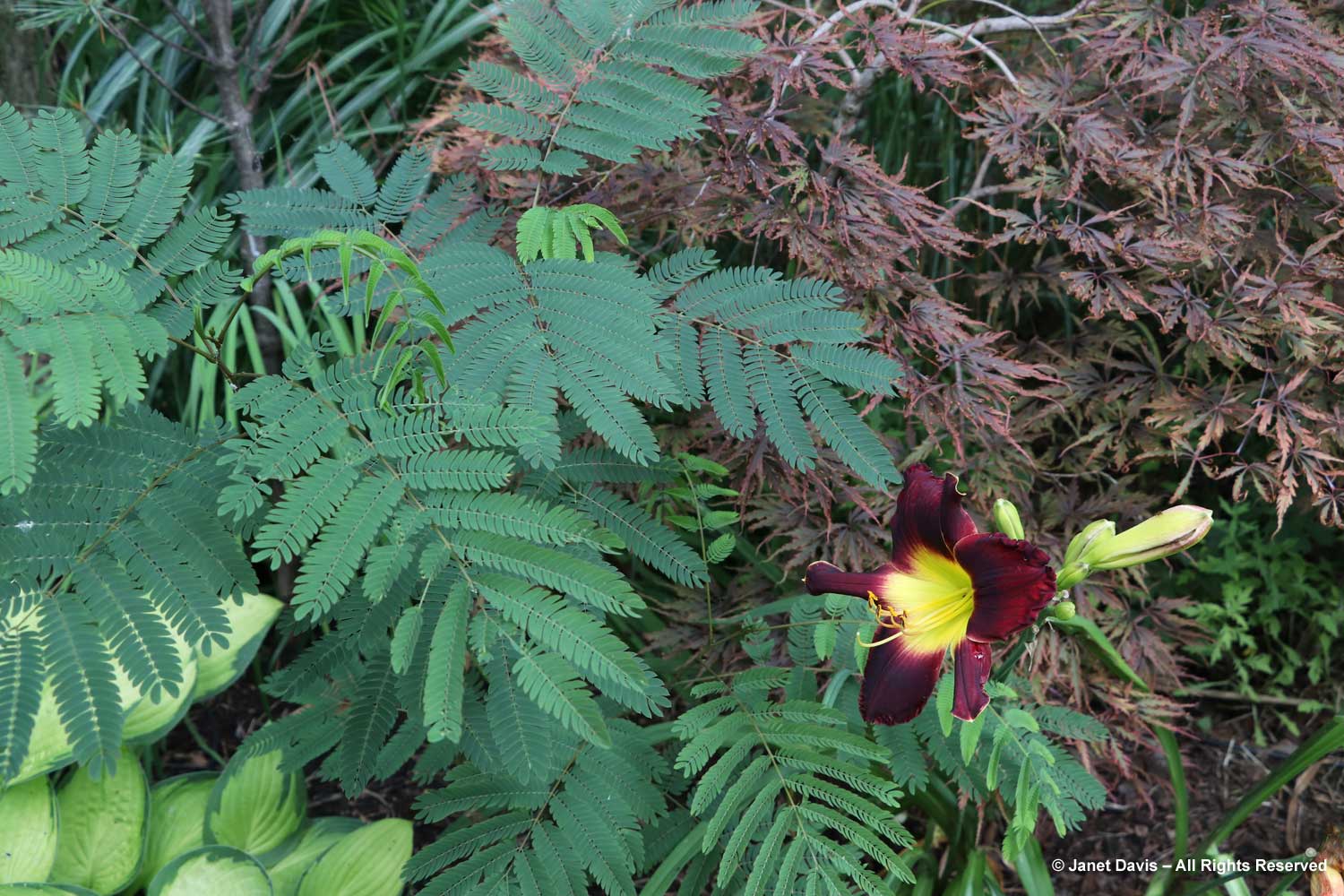
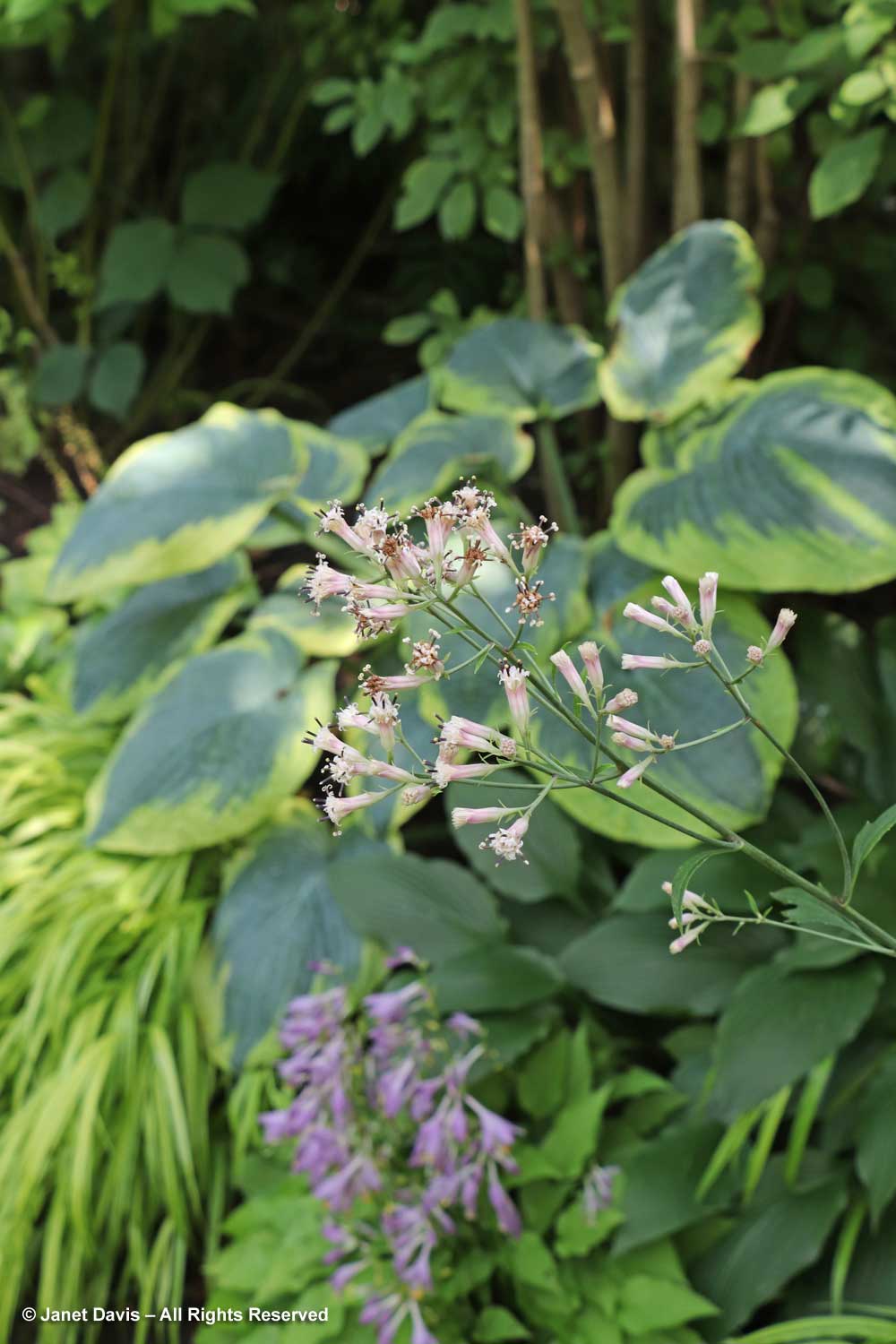
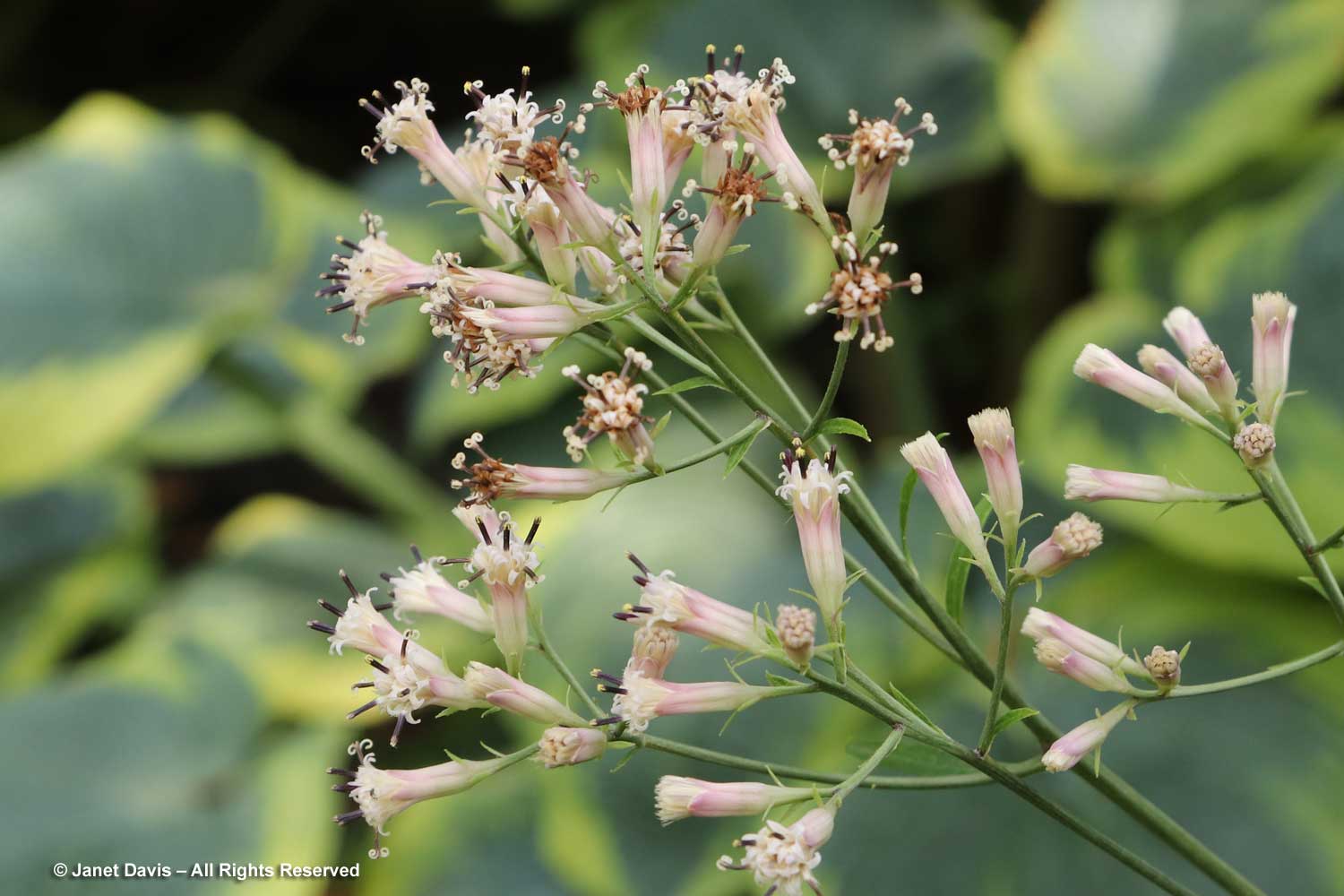

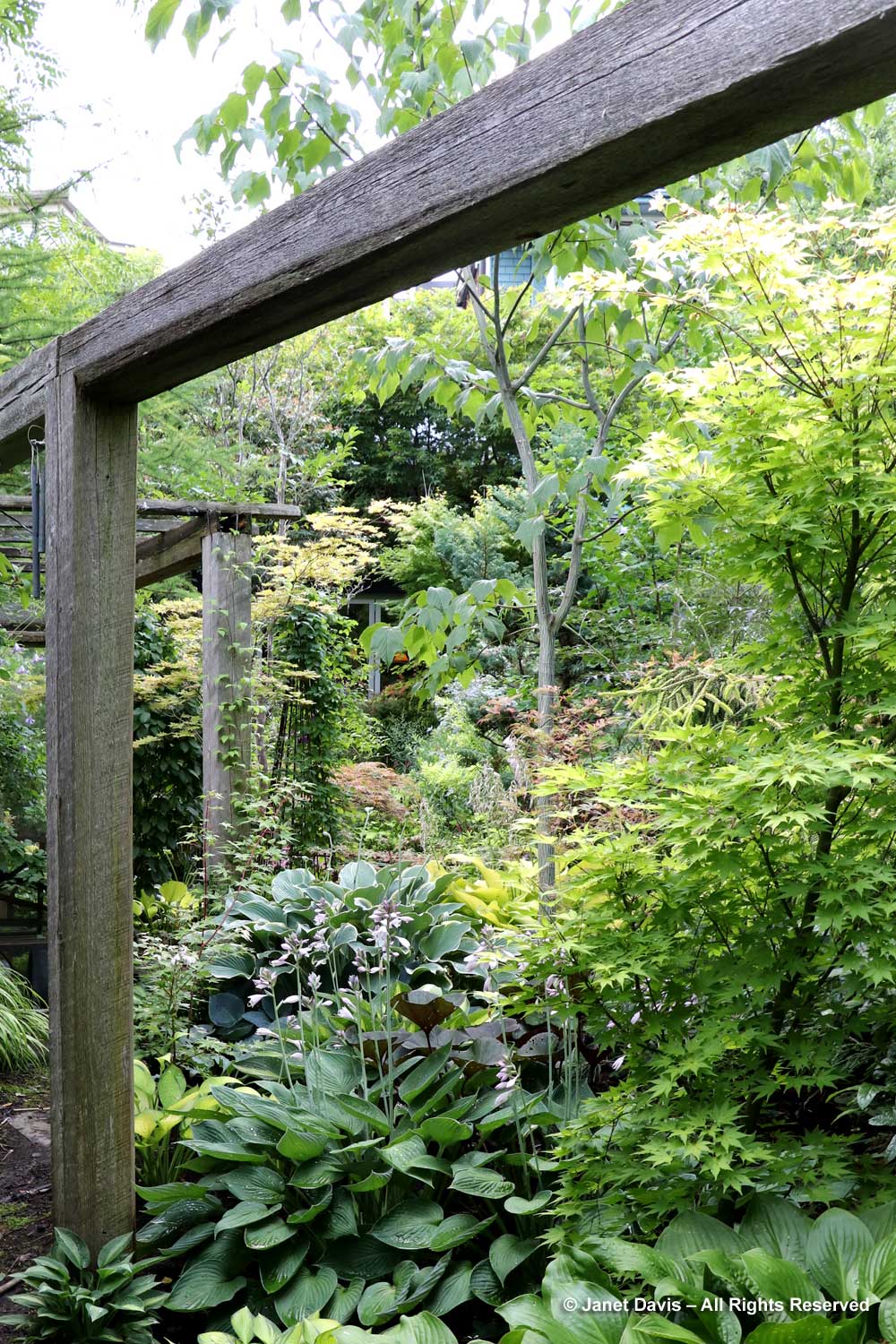
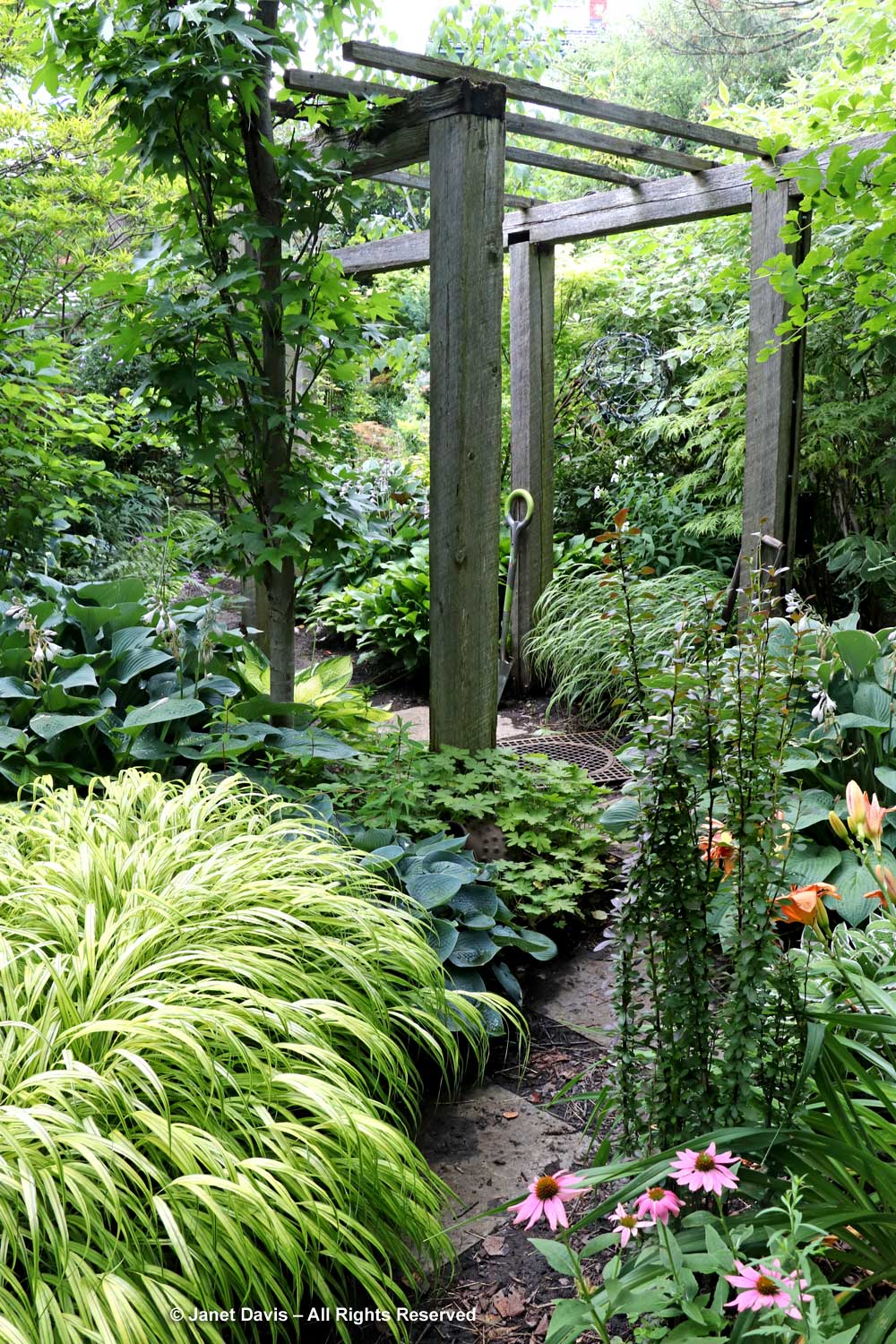

What a lovely tribute to our fiercely talented and accomplished friend. She is and always will be a force to be reckoned with; a true “woman of substance.” You’re a grand dame, Madge. (And you’re no slouch yourself, Janet Davis.)
Dear Aldona…. thank you. I’m so happy I got to see Marjorie’s work of art. I go off to tour gardens in NZ and Texas and Colorado and write about them, but this visit and blog was long overdue.
Well Janet this was a huge pleasure to read. Enjoyed every minute of both your visit snd your lovely article. My kind of gardening isn’t fir everyone but I do believe we should all be creating hedgerows that will keep the natural world close by. Thanks old pal xx
Dear M…. thank you for letting me come… and at such a perfect time of summer Keep on keeping on dear heart!
Such a timeless and peaceful garden. Thanks for sharing.
Thank you Albertina!
absolutely wonderful. thank you Janet and Marjorie…..
Thank you Kristl!
Lovely oasis in the city. Makes me feel better about my own backyard ‘jungle’. I also enjoyed reading the 1973 piece on women’s liberation in Canada.
Ha! You have good eyes; Jessica! I did not include the second page because I didn’t think people would be able to make out the first page!
Oh my…she’s an artist! What a beautiful feast for the eyes. Your photos are splendid and captured perfect angles and views. Although, I have not been there, they certainly look perfect to me. xog
Thank you Gail! She is an artist!
Marjorie’s book The Canadian Gardener was beside reading for me when I was fairly new to gardening, and I’ve often found myself doing her “creative staring” as part of my design process. Lovely post. I’m envious.
Helen…. yes. Her classic!
Wow, thanks for this lovely piece and your photos. Marjorie is a gem and exceptionally talented, and those us who know her are lucky to have her as a friend.
By the way, recently while staffing RBG’s garden info desk with a fellow volunteer — a retired nursery man, as it happens — he picked up Marjorie’s book, Botanica, and became enthralled. (Later, he told me that he found a used copy on Amazon and bought it: “It’s such a good book that I had to get my own copy.” )
How sad that the author doesn’t benefit when her books are resold. Such is life.
Thanks for this Yvonne. I have to fix my spam filter…. Yes, Botanica NA was a meaty, well researched book.